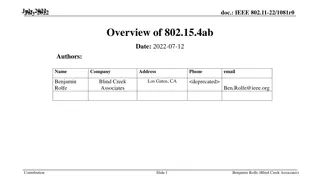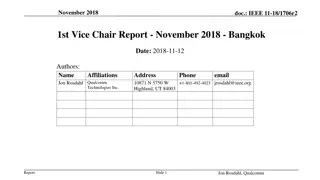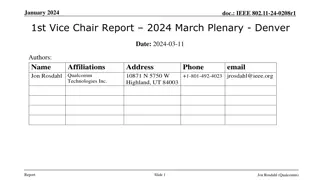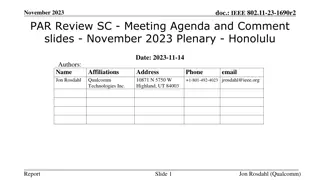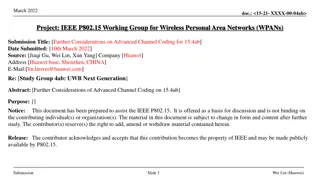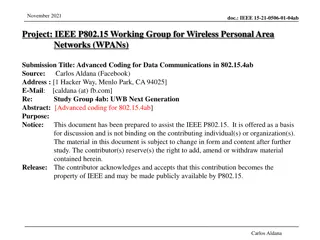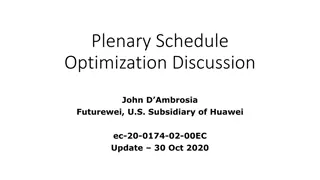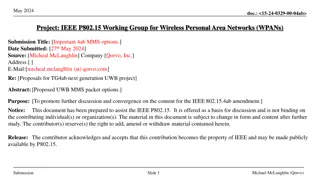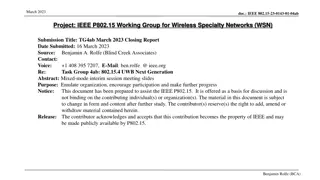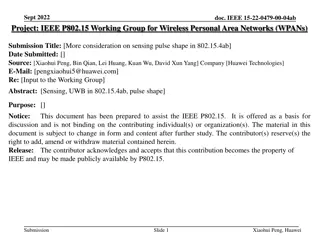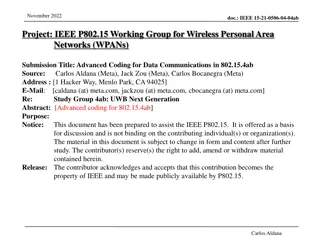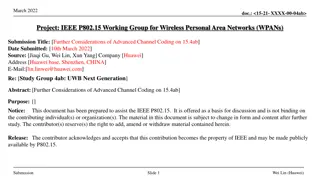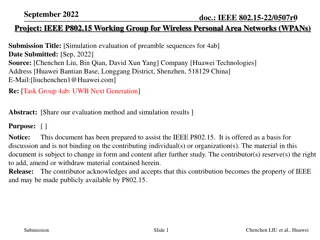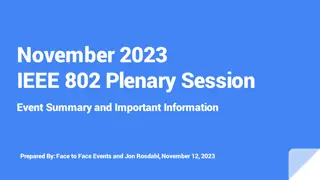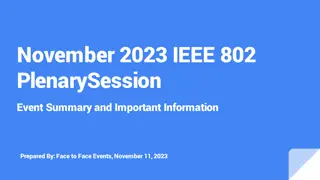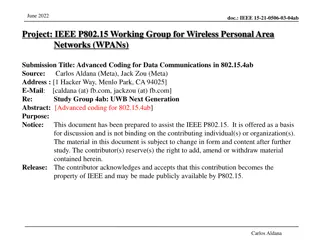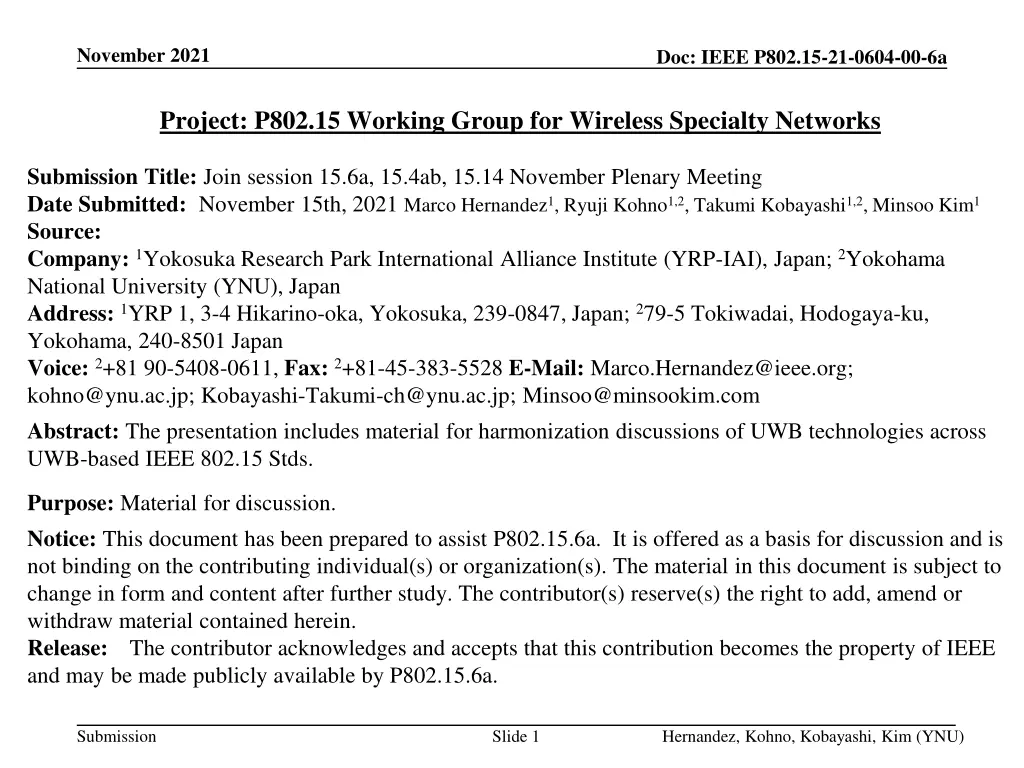
Advanced UWB Technologies for Wireless Networks: November 2021 Update
Explore the latest advancements in Ultra-Wideband (UWB) technologies for wireless networks discussed in the November 2021 IEEE P802.15 working group meeting. Topics include UWB channel models, technical requirements for coexistence, and potential common UWB Physical Layer developments, among others.
Download Presentation

Please find below an Image/Link to download the presentation.
The content on the website is provided AS IS for your information and personal use only. It may not be sold, licensed, or shared on other websites without obtaining consent from the author. If you encounter any issues during the download, it is possible that the publisher has removed the file from their server.
You are allowed to download the files provided on this website for personal or commercial use, subject to the condition that they are used lawfully. All files are the property of their respective owners.
The content on the website is provided AS IS for your information and personal use only. It may not be sold, licensed, or shared on other websites without obtaining consent from the author.
E N D
Presentation Transcript
November 2021 Doc: IEEE P802.15-21-0604-00-6a Project: P802.15 Working Group for Wireless Specialty Networks Submission Title: Join session 15.6a, 15.4ab, 15.14 November Plenary Meeting Date Submitted: November 15th, 2021 Marco Hernandez1, Ryuji Kohno1,2, Takumi Kobayashi1,2, Minsoo Kim1 Source: Company:1Yokosuka Research Park International Alliance Institute (YRP-IAI), Japan; 2Yokohama National University (YNU), Japan Address: 1YRP 1, 3-4 Hikarino-oka, Yokosuka, 239-0847, Japan; 279-5 Tokiwadai, Hodogaya-ku, Yokohama, 240-8501 Japan Voice:2+81 90-5408-0611, Fax:2+81-45-383-5528 E-Mail: Marco.Hernandez@ieee.org; kohno@ynu.ac.jp; Kobayashi-Takumi-ch@ynu.ac.jp; Minsoo@minsookim.com Abstract: The presentation includes material for harmonization discussions of UWB technologies across UWB-based IEEE 802.15 Stds. Purpose: Material for discussion. Notice: This document has been prepared to assist P802.15.6a. It is offered as a basis for discussion and is not binding on the contributing individual(s) or organization(s). The material in this document is subject to change in form and content after further study. The contributor(s) reserve(s) the right to add, amend or withdraw material contained herein. Release: The contributor acknowledges and accepts that this contribution becomes the property of IEEE and may be made publicly available by P802.15.6a. Submission Slide 1 Hernandez, Kohno, Kobayashi, Kim (YNU)
November 2021 Doc: IEEE P802.15-21-0604-00-6a From the September meeting Agreement to merge 15.4ab & 15.14 into one entity for baseline discussions. Identify minimal technical requirements for coexistence between 15.6a and 15.4ab&15.14. A starting point was about common channel models for evaluation of proposals. Submission Slide 2 Hernandez, Kohno, Kobayashi, Kim (YNU)
November 2021 Doc: IEEE P802.15-21-0604-00-6a Novel UWB channel models 15.6a is working on UWB channel models for VBAN Includes impact of EMI from vehicle's electric and electronic systems Interference from other wireless systems operating on the UWB band. Classification of interference environments. Advances in 15-21-0560-00-06a. Reuse 15.4a and 15.6 channel models for other use cases. Submission Slide 3 Hernandez, Kohno, Kobayashi, Kim (YNU)
November 2021 Doc: IEEE P802.15-21-0604-00-6a Potential common UWB PHY At the moment, 15.6a and 15.4ab are starting technical requirements for announcing a call for proposals Some technical contributions Some use cases contributions Technical Requirements Document (TRD) Technical Guidance Document (TGD) Submission Slide 4 Hernandez, Kohno, Kobayashi, Kim (YNU)
November 2021 Doc: IEEE P802.15-21-0604-00-6a Preliminary discussions 15.6a has a use case that requires the highest data rate with current technology (50 MB/s) Signals from a group of implant sensors on the brain concentrate in a fusion unit outside the skull. Such unit requires to transmit data information at 64 Mb/s using UWB radio interface. It impacts the total throughput required for 15.6a: PHY and MAC mechanisms. Submission Slide 5 Hernandez, Kohno, Kobayashi, Kim (YNU)
November 2021 Doc: IEEE P802.15-21-0604-00-6a Preliminary discussions In VBAN, HBAN scenarios, we require high dependability in terms of PDR (99%) and end-to-end latency (100msec, 250 msec) It impacts PHY and MAC design VBAN channel characterization Coordinator to coordinator framework 2-layer star topology or P2P topology Control congestion and interference Finishing TRD Submission Slide 6 Hernandez, Kohno, Kobayashi, Kim (YNU)
November 2021 Doc: IEEE P802.15-21-0604-00-6a Preliminary discussions In15.4ab, there are discussions on potential contributions: training sequences (M-sequences), capacity-achieving FEC, wake-up radio, aided NB radio, etc. We can start checking performance Max packet size for 15.4 is 127 bytes, while for 15.6 is 264 bytes Is 15.4ab holding a call for proposals? Submission Slide 7 Hernandez, Kohno, Kobayashi, Kim (YNU)
November 2021 Doc: IEEE P802.15-21-0604-00-6a Moving forward Some potential PHY proposals in 15.4ab are promising, like capacity-achieving FEC. Some others need careful examination, like using 2 radios (UWB + NB), long training sequences. Is 15.4ab expecting MAC proposals? Submission Slide 8 Hernandez, Kohno, Kobayashi, Kim (YNU)
November 2021 Doc: IEEE P802.15-21-0604-00-6a Comments a Submission Slide 9 Hernandez, Kohno, Kobayashi, Kim (YNU)


